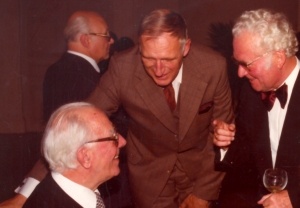| |
|
Biography of Jan Koetsier
(Short version) |
|
Jan Koetsier was born on 14 August
1911 in Amsterdam, the son of the singer Jeanne Koetsier and the
teacher Jan Koetsier-Muller. From an early age he received musical
encouragement and support (piano lessons). Koetsier decided to
study music early on, entering college straight after leaving
school. He moved to Berlin in 1913 with his family, and aged 16,
was the youngest student of his day to pass the entrance audition
in piano to the Berlin Hochschule für Musik. There, as well
as studying piano, he studied score-reading and music theory with
Walther Gmeindl, and conducting with Julius Prüwer from 1932.
Also encouraged by Artur Schnabel, signs of his future direction
in music began to emerge – composing and conducting. In
1933, Koetsier took up a position as a répétiteur
at the Stadttheater in Lübeck. But after just one concert
season, he returned to Berlin and began working as a conductor
touring with theatre ensembles such as the ‘Deutsche Musikbühne’
and the ‘Deutsche Landesbühne’; his repertoire
expanded to include music theatre works.
|
| 
|
From 1936/37 he had the opportunity of working
as a freelance conductor for the short-wave broadcasting station
in Berlin, directing broadcasts of his own folk music arrangements,
including arrangements of South American and African songs. Because
of the political situation, Koetsier gave up his position at the
Berlin radio station in 1940 and took up an offer of working as
piano accompanist to the dancer Ilse Meudtner on a year-long tour.
Following on from this, he worked as conductor of the newly-founded
Kammeropera in The Hague, during which he travelled to numerous
Dutch towns and cities (1941/42). He then became second conductor
of the ‘Concertgebouw Orchestra’ in Amsterdam (1942-48),
a central point in his artistic development, which brought with
it valuable stimuli and experience, including collaborating with
the orchestra’s chief conductor, Willem Mengelberg.
|
Jan Koetsier in 1937 at the University of Music
and Performing Arts Munich, conducting the Orchestra of „Deutsche
Landesbühne e.V. Berlin“. Using headphones he´s
controlling the recital of the soloist from the Swiss delegation.
|
He then spent a short period as conductor
of the ‘Residentie Orkest’ and as conducting teacher
at the Royal Conservatory in The Hague before being invited by
Bavarian Radio to become principal conductor of its newly-founded
Symphony Orchestra in 1950. Koetsier held this position for sixteen
years, working intensively on studio productions of all periods
and styles which were required for daily broadcasting. He also
conducted public concerts, including some in the Bavarian Radio
‘musica viva’ series. In 1966 he became professor
of conducting at the Hochschule für Musik in Munich, in which
position he was involved in reforming the teaching schedule. |
|
After his retirement, Koetsier concentrated mainly on composing
at his home in Rattenkirchen, Upper Bavaria. In these years, he
founded the International Jan Koetsier Competition for the encouragement
of young brass ensembles, since 1999 at the Hochschule für
Musik und Theater Munich.
Koetsier’s work with instrumental soloists and ensembles
led to numerous commissions. Musicians he frequently worked with
included the ‘Philip Jones Brass Ensemble’, the ‘Trio
Armin Rosin’ and the ‘Brass Philharmonie’ founded
by Armin Rosin, the ‘Slokar Quartet’, the ‘Rennquintett’,
the ‘Leipziger Hornquartett’ and the ‘Münchner
Blechbläsersolisten’, as well as numerous string soloists
and pianists. For many of these groups, his works have become
an established part of their repertoire. The fact that in his
composing, Koetsier always bore practical musical considerations
and requirements in mind is also a basic reason for his choice
of instrumental combinations and scorings; examples of this are
his combination of horn and harp (Sonata, Op. 94), four tubas
or trombones (‘Wolkenschatten’, Op. 136, for tuba
quartet; ‘Die Bremer Stadtmusikanten’, Op. 138, for
trombone quartet) or brass quintet and harp (‘Introduction
and Variations on the ‘Vyšehrad’ Theme by Friedrich
Smetana’, Op. 71). As well as chamber music for wind and
strings in various combinations, Koetsier also composed solo concerti
(e.g. the ‘Echo Concerto‘ for 2 piccolo trumpets and
string orchestra, Op. 124, or the Concerto for Brass Quintet and
Orchestra, Op. 133) and numerous orchestral works including symphonies
and serenades. Then there is piano and organ music, a few songs,
choral works and an opera (‘Frans Hals’, Op. 39).
|
 |
Many of these compositions have a firmly established
place in programme planning in Germany and abroad. Apart from
the chamber music, the solo concerti and orchestral works in particular
make worthwhile listening; for example, performances of his Concerto
for Trumpet, Trombone and Orchestra, Op. 17, by Rafael Kubelik
and the ‘Symphonieorchester des Bayerischen Rundfunks’
and the 3rd Symphony given by the ‘Philadelphia Orchestra’
in Philadelphia and New York were outstanding events.
Jan Koetsier in 1979 celebrating the 65th birthday of Rafael
Kubelik
|
In 2002 Koetsier gave up composing and moved with
his wife Margarete into the Augustinum Home in Munich. He died
there on 28 April 2006.
© Stephanie Mauder
|
|

